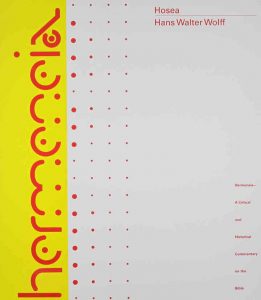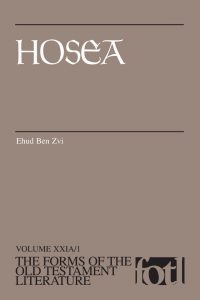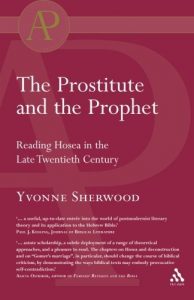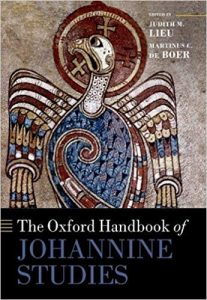Brad E. Kelle no artigo sobre Oseias 1-3, p. 202-208, trata dos estudos que olham o texto a partir de suas metáforas.
As the discussion thus far demonstrates, virtually every interpretive trend in scholarship on Hosea 1–3 has concerned itself in some way with the text’s metaphors. Since the 1980s, however, the study of Hosea through the lens of metaphor, especially the use of metaphor theory and the question of the primary function of the text’s marriage imagery, has achieved the dominant position in Hosea scholarship. Naturally, such studies make use of insights from historical reconstruction, comparative data, and gender analysis, but they are characterized by a central concern to elucidate the primary underlying issue(s) or rhetorical focus that stands behind Hosea’s metaphors. Part of the explanation for the prominence of these metaphorfocused studies is dissatisfaction with the results of biographical and historical readings.
(…)
In the various metaphor studies, we find three predominant interpretations of the overall rhetorical issue and metaphorical imagery in Hosea 1–3, with many overlapping features among them:
1. cultic-religious interpretation;
2. socio-economic interpretation; and,
3. historical-political interpretation.
(…)
1. Cultic-religious interpretation
The longest-standing interpretation of the imagery of Hosea 1–3, which has attained nearly unanimous support during various periods of the twentieth century,  understands the discourse as addressing a widespread religious conflict in eighth-century Israel between Yahwism and Baalism, and as symbolizing Israel’s apostasy through some form of the veneration of Baal (…) Since virtually all cultic-religious interpretations of Hosea 1–3 link these chapters in some way with a supposed Baalism active in Hosea’s day, scholarship has often looked to the text’s metaphors as sources for reconstructing the history of Israelite religion. Such religio-historical study has produced a massive amount of scholarly attention, and has moved from a relatively stable consensus in the middle of the twentieth century to a state of fragmented debate at present. General questions center on the proper definitions of Baal and Baalism in relation to Hosea’s language and imagery.
understands the discourse as addressing a widespread religious conflict in eighth-century Israel between Yahwism and Baalism, and as symbolizing Israel’s apostasy through some form of the veneration of Baal (…) Since virtually all cultic-religious interpretations of Hosea 1–3 link these chapters in some way with a supposed Baalism active in Hosea’s day, scholarship has often looked to the text’s metaphors as sources for reconstructing the history of Israelite religion. Such religio-historical study has produced a massive amount of scholarly attention, and has moved from a relatively stable consensus in the middle of the twentieth century to a state of fragmented debate at present. General questions center on the proper definitions of Baal and Baalism in relation to Hosea’s language and imagery.
(…)
The purported practice of cultic prostitution formed the most prominent example of such fertility interpretations of Hosea 1–3. Scholars drew evidence for this practice primarily from prophetic texts and classical writers like Herodotus, and suggested that Hosea’s sexual imagery portrays Israel as literally engaging in such rituals to Baal (e.g., Mays 1969: 3; Jacob, Keller, and Amsler 1965: 20). Since the 1980s, however, scholars have challenged nearly every aspect of the commonly cited literary and archaeological evidence for this practice in general, and its relevance for the study of Hosea 1–3 in particular (see Bucher 1988; Bird 1989; Nwaoru 1999; Keefe 2001; Kelle 2005). The present consensus seems to be that the notion of an institution of cultic prostitution providing the background for texts like Hosea 2 can no longer be sustained without great caution. These developments concerning the specific notion of cultic prostitution are representative of the changes that have occurred in the last two decades concerning the overall idea of a literal, sexual Baal cult as the key to the religious interpretation of Hosea’s metaphors. Virtually every ‘fertility rite’ proposed by earlier scholars (cultic prostitution, ritual defloration, sexual promiscuity at Baalistic worship festivals, etc.) has come under scrutiny, and the scholarly consensus has moved away from even the general concept of sexualized cultic practices as the background for a religious interpretation of Hosea 1–3’s central rhetorical issue.
(…)
Although the lack of evidence for a sexualized Baal cult in Hosea’s day has led most scholars to move away from cultic, fertility interpretations of Hosea 1–3, the dominant reading of these chapters continues to see widespread, non-sexual Baal worship in eighth-century Israel as the interpretive key for the text’s metaphors (e.g., Stuart 1987; Bucher 1988; Bird 1989; Garrett 1997). Hence, while the metaphors of fornication and adultery may not refer to literal sexual activity, they serve as negative metaphors describing Israel’s veneration of Baal. In keeping with recent changes in the study of the history of Israelite religion, however, the religious interpretation of Hosea 1–3 has become more complex than the notion of a simple conflict between Yahwism and Baalism. Some recent treatments, for example, identify the background of Hosea’s metaphors not as the Israelites’ abandonment of Yahweh for Baal, but as their syncretistic practice of blending or identifying Yahweh with Baal.
(…)
In sum, the dominant religious interpretation of the metaphors of Hosea 1–3 takes many forms in present scholarship, including a conflict between the rival gods Yahweh and Baal, the veneration of numerous local deities, the blending of Yahweh and Baal in Israelite worship, and the presence of ‘non-orthodox’ forms of Yahwism as a part of ‘popular’ religion. These various religious reconstructions and rhetorical analyses, as opposed to the literal sex-cult readings of earlier in the twentieth century, represent the present primary form of the religious interpretation of Hosea’s language and imagery.
2. Socio-economic interpretation
A socio-economic reading of the metaphors of Hosea 1–3 has emerged more recently (…) These studies read the prophet’s speech as directly concerned with shifting social, political, and economic relationships among king, cult, priest, and prophet within Israel’s body politic (…) The female body being prostituted in Hosea 1–3 ymbolizes the social body of eighth-century Israel in the midst of a crisis over communal identity and socio-economic practice (…) Through the symbol of a female body that accepts illegitimate lovers, Hosea condemns Israel’s social body, especially the royal elites who govern it, as accepting a new social organization based on land accumulation and dispossession.
3. Historical-political interpretation
A number of individual studies of different aspects of Hosea 1–3 have moved toward a more thoroughly political interpretation of Hosea’s metaphors (…) Citing the lack of evidence for widespread Baal worship in eighth-century Israel, some of these works (e.g., Schmitt 1989) examine the wife/mother image in Hosea 2 against its ancient Near Eastern background as a metaphor for the capital city of Samaria, and thus for the political leaders who rule there. Others observe the prevalent use of ‘lovers’ as a metaphor for allies in ancient Near Eastern political treaties and biblical texts (see Ackerman 2002; Yee 2003: 104; Kelle 2005: 112-22), as well as the use of ‘fornication’ as a metaphorical vehicle for political and commercial alliances (e.g., Day 2006).
(…)
From these and other observations, Kelle has suggested that Hosea 2 in particular is a rhetorical discourse that attempts to persuade the prophet’s audience to a particular perspective regarding a political crisis. Hosea condemns the political rulers in the capital city of Samaria for their involvement with Aram-Damascus during the Syro-Ephraimitic War by feminizing them as sexually loose women, labeling their political alliances as fornication and adultery, and using the term ‘baal’ for their Aramean ally, in order to evoke an association with sinful Baal worship of Israel’s earlier history. Thus, the metaphors of Hosea 2 work together as a rhetorical speech that offers a metaphorical and theological commentary on the political affairs of Samaria at the time of the Syro-Ephraimitic War, ultimately asserting that the ‘political misdeeds of Samaria and her rulers are equivalent to the religious apostasy of previous generations and constitute a complete abandonment of Yahweh’ (Kelle 2005: 283-84).
 Como se pode perceber, virtualmente toda tendência interpretativa nos estudos sobre Oseias 1–3 preocupou-se de alguma forma com as metáforas do texto. Desde a década de 80 do século XX, no entanto, o estudo de Oseias através das lentes da metáfora, especialmente o uso da teoria da metáfora e a questão da função primária das imagens matrimoniais do texto, alcançou uma posição de destaque nos estudos de Oseias. Naturalmente, esses estudos fazem uso de insights de reconstrução histórica, dados comparativos e análise de gênero, mas eles são caracterizados por uma preocupação central em elucidar a principal questão subjacente ou foco retórico que está por trás das metáforas de Oseias. Parte da explicação para o aparecimento desses estudos focados em metáforas é a insatisfação com os resultados das leituras biográficas e históricas.
Como se pode perceber, virtualmente toda tendência interpretativa nos estudos sobre Oseias 1–3 preocupou-se de alguma forma com as metáforas do texto. Desde a década de 80 do século XX, no entanto, o estudo de Oseias através das lentes da metáfora, especialmente o uso da teoria da metáfora e a questão da função primária das imagens matrimoniais do texto, alcançou uma posição de destaque nos estudos de Oseias. Naturalmente, esses estudos fazem uso de insights de reconstrução histórica, dados comparativos e análise de gênero, mas eles são caracterizados por uma preocupação central em elucidar a principal questão subjacente ou foco retórico que está por trás das metáforas de Oseias. Parte da explicação para o aparecimento desses estudos focados em metáforas é a insatisfação com os resultados das leituras biográficas e históricas.
(…)
Nos vários estudos sobre as metáforas de Oseias 1-3, encontramos três interpretações predominantes:
1. interpretação cultual
2. interpretação socioeconômica
3. interpretação histórico-política
(…)
1. Interpretação cultual
A interpretação mais duradoura das imagens de Oseias 1–3, que alcançou apoio quase unânime durante vários períodos do século XX, compreende o discurso como se referindo a um conflito religioso generalizado no Israel do século VIII a.C. entre o javismo e o baalismo, e como simbolizando a apostasia de Israel através de alguma forma de culto a Baal (…) Dado que virtualmente todas as interpretações cultuais de Oseias 1–3 ligam esses capítulos de alguma forma a um suposto baalismo ativo nos dias de Oseias, os estudos frequentemente consideram as metáforas do texto como fontes para reconstruir a história da religião israelita. Esse estudo histórico-religioso chamou a atencão da academia e passou de um consenso relativamente estável em meados do século XX para um estado de debate fragmentado no momento [2009]. As questões mais importantes dizem respeito às definições adequadas de Baal e baalismo em relação à linguagem e às imagens de Oseias.
(…)
A suposta prática da prostituição cultual formou o exemplo mais marcante de tais interpretações de fertilidade de Oseias 1–3. Estudiosos extraíram evidências para essa prática principalmente de textos proféticos e escritores clássicos como Heródoto, e sugeriram que as imagens sexuais de Oseias retratam Israel como literalmente envolvido em tais rituais para Baal. Desde a década de 80, no entanto, estudiosos têm desafiado quase todos os aspectos das evidências literárias e arqueológicas comumente citadas para esta prática em geral, e sua relevância para o estudo de Oseias 1–3 em particular. O consenso atual parece ser que a noção de uma instituição de prostituição cultual fornecendo o pano de fundo para textos como Oseias 2 não pode mais ser sustentada sem grande cautela. Esses desenvolvimentos relativos à noção específica de prostituição cultual são representativos das mudanças que ocorreram nas duas últimas décadas em relação à ideia geral de um culto sexual literal de Baal como a chave para a interpretação religiosa das metáforas de Oseias. Praticamente todos os ‘ritos de fertilidade’ propostos por eruditos anteriores (prostituição cultual, defloração ritual, promiscuidade sexual em festivais baalistas etc.) estão sob suspeita, e o consenso erudito afastou-se significativamente do conceito geral de práticas cultuais sexualizadas como pano de fundo para uma interpretação religiosa de Oseias 1–3.
(…)
Embora a falta de evidência de um culto sexualizado de Baal nos dias de Oseias tenha levado a maioria dos estudiosos a abandonar as interpretações cultuais de fertilidade de Oseias 1–3, a leitura dominante desses capítulos continua a ver o culto generalizado e não sexual de Baal no Israel do século VIII a.C. como a chave interpretativa para as metáforas do texto. Assim, enquanto as metáforas da fornicação e do adultério podem não se referir à atividade sexual literal, elas servem como metáforas negativas descrevendo o culto de Israel a Baal. Contudo, de acordo com as recentes mudanças no estudo da história da religião israelita, a interpretação religiosa de Oseias 1–3 tornou-se mais complexa do que a noção de um simples conflito entre o javismo e o baalismo. Algumas abordagens recentes, por exemplo, identificam o pano de fundo das metáforas de Oseias não como o abandono de Iahweh por Baal por parte de Israel, mas como a prática sincrética de misturar ou identificar Iahweh com Baal.
(…)
Resumindo, a interpretação religiosa dominante das metáforas de Oseias 1–3 toma muitas formas na pesquisa atual, incluindo um conflito entre os deuses rivais Iahweh e Baal, o culto de numerosas divindades locais (os baalim), o sincretismo de Iahweh e Baal no culto israelita, e a presença de formas “não-ortodoxas” do javismo como parte da religião “popular”. Essas várias reconstruções, em oposição às leituras literais do início do século XX, representam a principal forma atual da interpretação religiosa da linguagem e das imagens de Oseias.
2. Interpretação socioeconômica
Uma leitura socioeconômica das metáforas de Oseias 1–3 apareceu mais recentemente (…) Esses estudos leram o discurso do profeta como diretamente relacionado à mudança das relações sociais, políticas e econômicas entre o rei, o culto, o sacerdote e o profeta na organização política de Israel (…) O corpo feminino sendo prostituído em Oseias 1–3 simboliza o corpo social do Israel do século VIII a.C. em meio a uma crise de identidade e condena as práticas socioeconômicas da época (…) Através do símbolo de um corpo feminino que aceita amantes ilegítimos, Oseias condena o corpo social de Israel, especialmente as elites reais que o governam, porque impõem uma nova organização social baseada na desapropriação e acumulação de terras.
(…)
3. Interpretação histórico-política
Uma série de estudos específicos sobre diferentes aspectos de Oseias 1–3 avançaram em direção a uma interpretação mais política das metáforas de Oseias (…) Citando a falta de evidência do difundido culto a Baal no Israel do século VIII a.C., algumas dessas obras examinam a imagem da esposa/mãe em Oseias 2 como uma metáfora para a cidade de Samaria e, portanto, para os líderes políticos que lá governam. Outros observam o uso predominante de “amantes” como uma metáfora para aliados em tratados políticos do antigo Oriente Médio, bem como o uso de “fornicação” como um veículo metafórico para alianças políticas e comerciais.
(…)
Brad E. Kelle, por exemplo, sugeriu que Oseias 2 é um discurso retórico que tenta persuadir o público do profeta sobre uma crise política a partir de um ponto de vista específico. Oseias condena os governantes políticos na capital Samaria por seu envolvimento com Aram-Damasco durante a Guerra Siro-Efraimita, feminilizando-os como mulheres sexualmente dissolutas, rotulando suas alianças políticas como fornicação e adultério, e usando o termo ‘baal’ para seu aliado arameu. Assim, as metáforas de Oseias 2 funcionam como um discurso retórico que faz um comentário metafórico e teológico sobre os assuntos políticos de Samaria na época da Guerra Siro-Efraimita, afirmando em última instância que os “erros políticos de Samaria e seus governantes são equivalentes à apostasia religiosa das gerações anteriores e constituem um completo abandono de Iahweh” (KELLE, B. E. Hosea 2: Metaphor and Rhetoric in Historical Perspective. Atlanta: Society of Biblical Literature, 2005, p. 283-284. Disponível online).
 Oseias à monarquia de várias formas. São três as posições principais dos estudiosos:
Oseias à monarquia de várias formas. São três as posições principais dos estudiosos:





